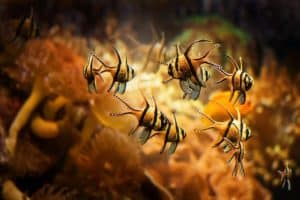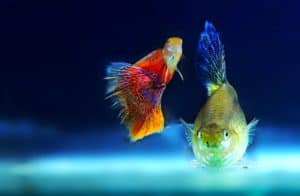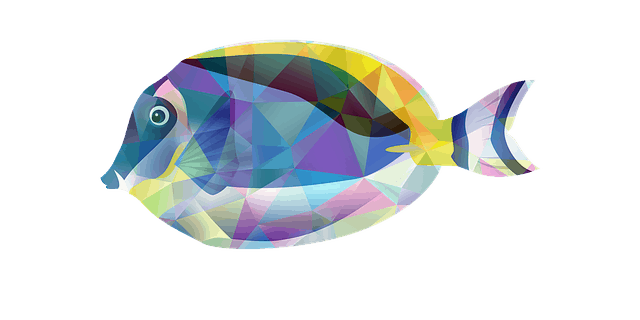Moving homes is something all of us most likely hate with a passion. It’s a new environment, and it takes some time to adjust. Everything is out of place, and it’s not an atmosphere that we are comfortable in. At least not yet. The same goes for your fish. Changing aquariums is the same thing as changing homes for us. The goal is to make this transition as easy as possible not only on yourself but for your fish as well.
It’s stressful for your fish. You need to keep that in mind anytime to you change aquariums. Thinking back to when I first started with fish keeping, I remember a question that I had. Looking back, I understand how important this question is to have a direct clean answer for. How do you introduce new fish to an aquarium? After going through this process, myself and some independent research. Here is what I have learned.
So, how do you introduce new fish to an aquarium? First, you should always learn about your fish and speak to an expert about the best precautions to take. Secondly, you need to ensure clean water quality and that your tank is the proper size. Third, you allow floating time to adjust to the new water temperature.
While that seems like an easy answer and something you could complete in a matter of minutes, it’s not. It’s more involved than that. The statement above is merely a three-step direct answer for those in a rush to complete the process.
For those who want to really ensure you are taking the perfect measures to add fish to an aquarium, I suggest you read on for more advice. I will give you more of the procedures and best practices to make sure your fish has a stress free and healthy introduction to the new aquarium.
Understanding the Acclimation Process for Your Fish
Keep in mind, that when you have a new fish that’s ready to be added to an aquarium, it’s probably sitting in a small bag with a small amount of water and a small amount of oxygen available. This alone isn’t an issue. Due to this, some science is taking place behinds the scenes that you may not be aware of. Let’s look at a few factors to consider.
Ammonia Levels- These Can Become Dangerous
That small bag of water that your fish is currently sitting in awaiting transfer to the tank only has a small amount of water. In this situation, your fish will be consuming the oxygen that is available until the transfer. This produces ammonia within the bag itself. The longer your fish remains in this bag before transfer, the more ammonia that will be produced.
Continuous Breathing the Oxygen in Water
Your fish will continuously breathe and consume the dissolved oxygen within the water. When this happens, the oxygen is slowly depleted. Through the chemical exchange, the oxygen used will be replaced with carbon dioxide. This alone is nothing to worry about either. Let’s talk about it for a second.
PH Levels- Rapid Rise and Rapid Drops Can Be Harmful
Now the problem starts to happen. When the carbon dioxide is introduced to the bag through the gas exchange, pH levels begin to drop. This alone isn’t something deadly or something to worry about. Lower pH levels cause the ammonia levels to become safer and less lethal, but the danger really kicks in when the small bag of water is opened (we will discuss how to battle against this a bit further in the post)
The Rise of the pH and the Impact on the Ammonia
Now, let’s assume you are preparing to complete the transfer. Once you open the bag, you expose the water to oxygen once again. The waters pH levels rise almost immediately. It’s at this point, that if you take the wrong steps, you may kill your fish. When the pH levels rise this quickly, it makes the ammonia within the water extremely toxic.

Size of Fish- This Can Make A Difference
The last consideration before diving into the transfer is the size of the fish. When you have a larger fish within the bag before you transfer the fish to the tank, it speeds up the dangerous process discussed previously with changing pH levels and ammonia toxicity. This is due strictly to the amount of oxygen that’s consumed and how quickly it’s consumed by larger fish as opposed to smaller fish.
Now that we understand ammonia and pH level considerations let’s dive into water temperature and other potential issues you may face during the transfer.
Water Temperature and How it Impacts Your Fish- Let Them Give It A Test Drive
One big key to consider is allowing the fish 15-20 minutes to get used to the new water temperature. You can do this by floating the fish (within the bag). Most believe this suffices and won’t harm the fish. In most instances, it’s a perfectly fine method. However, you may be surprised to know that it can take upwards of a week for a fish to get fully acclimated to a new tank and the new water temperatures.
A Cold-Blooded Creature- Eliminate the Potential for Shock Periods
Those that skip this process altogether are going to run into some issues quickly. It’s not a good idea. Fish are not like us. They are cold-blooded, meaning that when you place your fish in the new tank, you are either causing a drop or a rise in the entire body temperature of the fish. This is 100% different from humans who are warm-blooded.
We can walk outside when it’s freezing cold, but our body remains warm (on the inside) for a period. With a fish, it’s going to change the entire body temperature rapidly, and this is often a step that can stress or kill the fish if not handled properly. Even just giving a small acclimation period, removes the risk of the “shock period” which provides you with a much stronger chance of your fish transferring without death.
Coming Back to The Ammonia Issue- Be Sure to Detoxify
We spoke about how the ammonia levels are at a toxic level in some situations when introducing the new fish to an aquarium. To battle back against this, you can merely add ammonia detoxifier to the water at the recommended levels.
This will be one of the final steps to ensuring you have a clean transfer losing minimal amounts of fish if any fish in the process. Amazon sells a product called API Ammo-Lock that will get this job done for you flawlessly.
What If I Don’t Have Ammonia Detoxifier on Hand or I forgot It?
If this is the case, you still need to allow the fish time to acclimate to the water temperature. If you don’t have the ammonia detoxifier on hand, you will want to complete the transfer as quickly as possible. This is going to eliminate some of those elements discussed previously and will give the fish the best chance at surviving the transfer.

Other Considerations and Tips to Add Fish to A New Aquarium
I wanted to give you just a few more tips and tricks to ensuring you add your new fish to the aquarium in the best possible manner.
Tip #1- Use a large Net for a Transfer
The bigger the net the better. Small nets are more laborious to flip and successfully drop the fish into the tank. Especially if you have any larger new fish to add to the tank. If you’re interested in investing in a larger net check out this fish net on Amazon.
Tip #2- Turn off the Aquarium Lights
You should always turn off the aquarium lights when introducing new fish to an aquarium/tank. You want to keep stress levels at a minimum if it’s possible. Lights add to the stress on the fish and should be avoided.
Putting It All Together- A Fairly Simple but Often Overlooked Process
Adding new fish to a tank is not necessarily difficult. We have discussed in the past how important it is to understand your fish and to complete these tasks in the most ethical manner possible. The more you know, the better and fish keeping does have a learning curve. I get it and have been there. However, if you allow your fish time to adjust to the temperature, keep ammonia toxicity at a minimum and follow the other steps laid out for you here today, then you shouldn’t have much to worry about.
You will have your new fish getting comfortable in no time and slowly become more seasoned and better with this process over time.
Related Questions
How Long Should I Let My Fish Sit in The Bag?
As stated previously, 15-20 minutes should be long enough in nearly all circumstances. We don’t have all day to allow them to sit in the floating bag awaiting the transfer into the new tank. Once your fish has acclimated and completed this floating period, you can just cut the bag and fold down the sides to release the fish into the water. Remember that during this process the lights on the aquarium should be off and if you have ammonia detoxifier (recommended) on hand, it should be added to the tank as well.
Related Posts
How to Introduce a New Aquarium Filter?
How to Transport Fish Safely [Tips to Safely Moving Your Fish]




